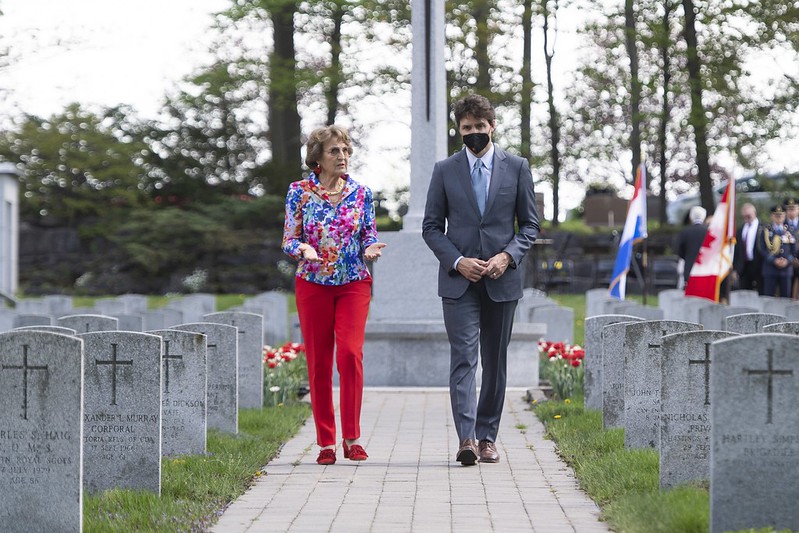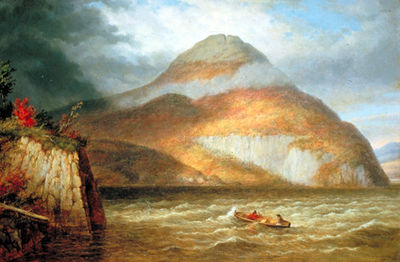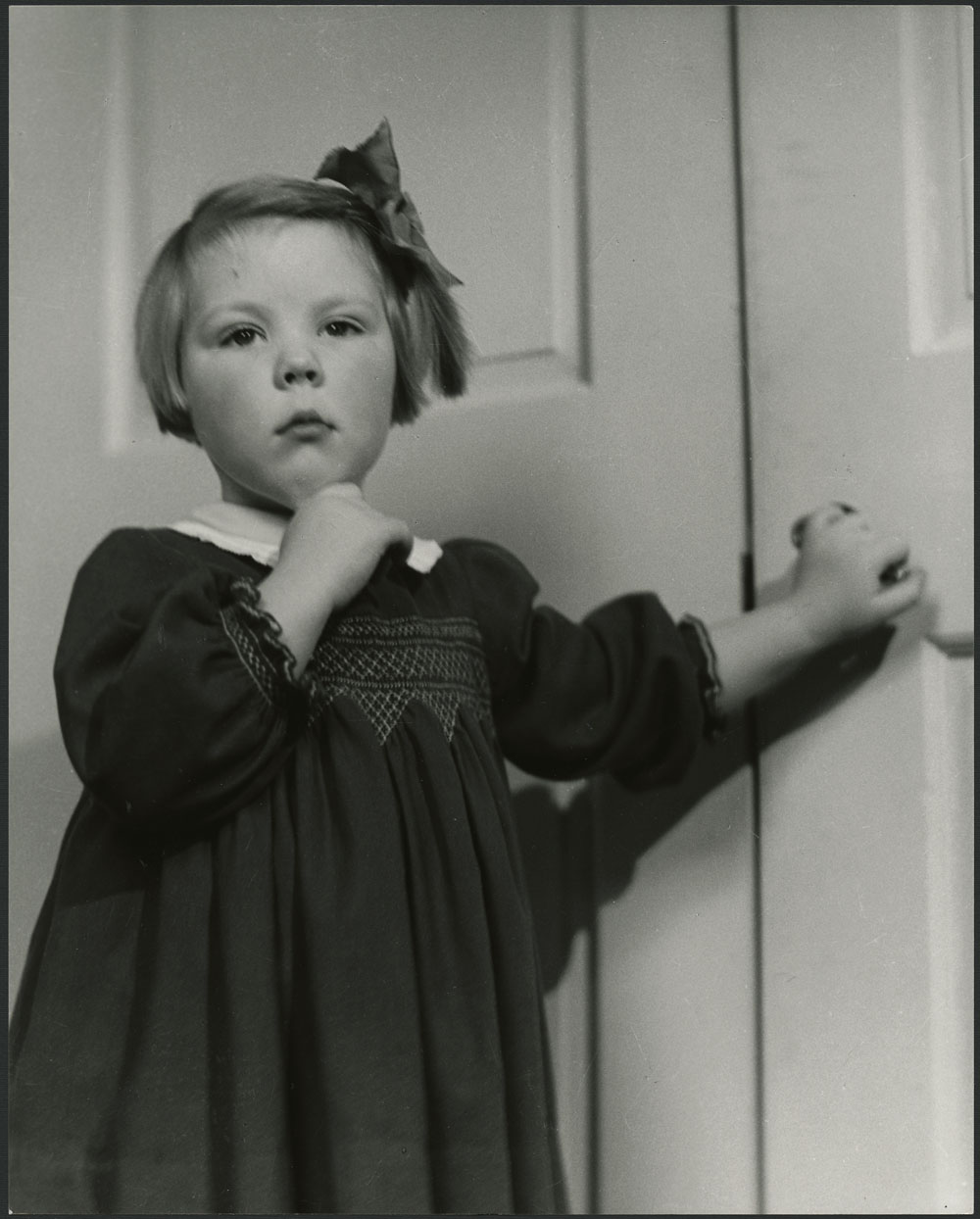Her Royal Highness Princess Margriet Francisca of the Netherlands, Princess of Orange-Nassau, Princess of Lippe-Biesterfeld (born 19 January 1943 in Ottawa, ON) spent her early childhood in Canada during the Second World War. The annual Canadian Tulip Festival in Ottawa emerged from gifts of thousands of tulip bulbs from the Dutch royal family. Margriet continues to make regular visits to Canada, strengthening ties between Canada and the Netherlands.

The Dutch Royal Family in Canada
Margriet was the third of four daughters of Crown Princess Juliana of the Netherlands (who succeeded to the Dutch throne as Queen Juliana in 1948) and Prince Bernhard of Lippe-Biesterfeld. In 1940, the Dutch royal family fled the Nazi invasion of the Netherlands. Margriet’s grandmother, Queen Wilhelmina, stated in a radio broadcast, “In a country with restricted freedom there is no place for the house of Orange.” The Dutch royal family initially took refuge in the United Kingdom but concerns for the safety of Juliana and her children during the German bombing of Britain in 1940 resulted in Juliana and her daughters, the future Queen Beatrix (born 1938) and Princess Irene (born 1939), accepting an invitation from the governor general of Canada, the Earl of Athlone, and Princess Alice, Countess of Athlone (Queen Wilhelmina’s first cousin) to reside in Canada for the duration of the Second World War. The family first resided with the viceregal couple at Rideau Hall then moved to 120 Lansdowne Road in Ottawa. Like Queen Wilhelmina, Bernhard remained in Britain, where he was a liaison officer and RAF pilot; however, they made frequent visits to Juliana and the children in Canada.

Birth in Ottawa
News that Princess Juliana was expecting her third child was broadcast in the autumn of 1942. In hiding with her family in Amsterdam, Anne Frank wrote in her diary on 21 September, “I sometimes listen to the Dutch broadcasts from London. Prince Bernhard recently announced that Princess Juliana is expecting a baby in January, which I think is wonderful. No one here understands why I take such an interest in the Royal Family.” In his radio broadcasts, Bernhard warned the Dutch against celebrating openly while still under occupation.
If the baby was a boy, he would be next in line to the Dutch throne after his mother, Crown Princess Juliana. The Earl of Athlone therefore decreed that the maternity ward at the Ottawa Civic Hospital would be declared extraterritorial for the birth, ensuring that the baby would have Dutch citizenship alone. Four rooms were set aside at the Ottawa Civic Hospital for Juliana, the baby, the nurse and the security team.
Margriet was named for the daisies worn by members of the Dutch resistance. Queen Wilhelmina stated in a radio broadcast, “It is the intention of the parents through their choice of a name to establish a lifelong bond between our grievously tried people in the occupied part of the kingdom and the newly born.” Juliana told her husband, “I’m really glad it’s a girl. If it had been a son, perhaps there would have been too much excitement in Holland and even victims. Now, I can breathe easier.”
Margriet’s birth prompted widespread rejoicing. F.E.H. Groenman, the Dutch minister to Canada stated at a reception that he hosted, “For us, 1943 is the year of our rising hope.” In honour of her birth, the Dutch flag flew from Ottawa’s Peace Tower (the first time a foreign flag was flown alone from the Parliament Buildings) and the bells played the Dutch national anthem.
Margriet’s christening took place at St. Andrew’s Presbyterian Church in Ottawa on 29 June 1943. Crowds outside the church applauded the arrival of the Earl and Countess of Athlone with the baby’s grandmother, Queen Wilhelmina. The Earl of Athlone, American president Franklin Roosevelt, and members of the Dutch merchant marine were among her godparents. With the arrival of a third daughter, Juliana and her children moved into a larger residence, Stornoway in Rockcliffe Park, which is now the residence of the leader of the official opposition, where they lived for the remainder of the Second World War.
The birth of Margriet prompted Canadian donations to Dutch wartime relief organizations. Juliana told a visitor, “Canadians are so nice. After the baby was born, we were flooded with telegrams and flowers. I was so touched by the big gifts from Canadian societies to Netherlands relief.”

The Tulip Tradition
In 1945, following the liberation of the Netherlands by the Allies, including Canadian forces, the Dutch royal family returned home, residing at the Soestdijk Palace near Baarn. Princess Juliana sent 100,000 tulip bulbs to Canada in thanks for the refuge provided for her family and the role of the Canadian forces in the liberation of the Netherlands, followed by a further gift of 20,500 tulip bulbs the following year with a request that a portion of these bulbs be planted on the grounds of the Ottawa Civic Hospital where Margriet was born. These gifts of tulips inspired the first Canadian Tulip Festival in 1953. In 1967, Juliana returned to Ottawa and unveiled a plaque stating, “Canada was honoured when Her Royal Highness Princess Juliana, now Queen of the Netherlands, found refuge in Canada’s capital during the occupation of her homeland, 1940 to 1945. Her Majesty’s gifts of tulips each year have created great beauty for the enjoyment of residents and visitors.” The Netherlands continues to send Canada 10,000 tulip bulbs per year for the festival.
Marriage and Children
In 1967, Margriet married Pieter van Vollenhoven (born 1939), whom she met while studying law at Leiden University. Princess Alice, Countess of Athlone was one of the wedding guests. The marriage was the first instance of someone without a royal or noble title marrying into the Dutch royal family and he remained Mr. (later Professor) van Vollenhoven. Pieter van Vollenhoven became a professor of risk management and chaired transport safety committees in addition to accompanying Margriet on royal tours and engagements. The couple have four sons — Prince Maurits (born 1968), Prince Bernhard (born 1969), Prince Pieter-Christiaan (born 1972) and Prince Floris (born 1975) — and eleven grandchildren.
Did you know?
Princess Margriet’s youngest son, Prince Floris, is the godson and honorary vice president of the Royal Canadian Legion.
Humanitarian Work
Margriet has been involved in extensive humanitarian work focused on global health. From 1987 to 2011, Margriet was vice president of the Netherlands Red Cross, chairing the Standing Commission of the Red Cross and Red Crescent from 1995 to 2003. She was also a member of the board of the International Federation of Red Cross and Red Crescent Societies. She was president of the European Cultural Foundation from 1984 to 2007 and is a member of the Honorary Board of the International Paralympic Committee.
Relationship with Canada
Margriet has travelled extensively in Canada, visiting Ottawa, St. Catharines and Calgary on a three-week tour in 1968. In 1970, 1978 and 1979, Margriet and her husband visited the far north. In 1974 and 1986, Margriet visited Toronto and Vancouver respectively to mark the start of direct KLM flights to these cities. In 1979, she presented a contribution to the Ottawa Civic Hospital’s fundraising campaign on behalf of her mother, Queen Juliana. In 1982, she visited British Columbia to promote Dutch-Canada trade links and in 1983, she opened an exhibition of Dutch Paintings of the Golden Age at the Art Gallery of Ontario in Toronto.
Margriet has attended the Canadian Tulip Festival in Ottawa on numerous occasions, celebrating the 50th anniversary of the event in 2002. She also attends events in Canada honouring Canadian veterans of the Second World War. In 1990, she attended the annual convention of the Royal Canadian Legion. In May 2005, Margriet and her husband visited Montreal and Ottawa to mark the 60th anniversary of the liberation of the Netherlands. Five years later, she visited Ottawa and Calgary for the 65th anniversary. There are more than 1 million Canadians of Dutch descent and Margriet attends events held by the Dutch-Canadian community during her visits to Canada.
In May 2017, Margriet visited Toronto, Brampton, Stratford, Goderich, Hamilton and Burlington to honour the anniversary of the liberation of the Netherlands by the Canadian Armed Forces during the Second World War. Burlington is twinned with Apeldoorn, where Margriet and her family live on the grounds of Het Loo Palace. Margriet is the honorary chair of the advisory board for the Master of Global Health Program offered in partnership by Maastricht University in the Netherlands and McMaster University in Hamilton.
On 16 November 2012, Margriet received an honorary doctorate of laws from McMaster University in honour of her international humanitarian work. In her acceptance speech, Margriet emphasized the close relationship between Canada and the Netherlands, stating, “My mother and two sisters found shelter in Canada during the Second World War.… I feel Canada is my second homeland. In the Netherlands we keep alive the memory of Canada’s pivotal role in the liberation of our country. Schoolchildren tend the graves of Canadian soldiers who paid the ultimate price to bring us freedom.”
In September 2019, Margriet presented a box of “Liberation75” tulips to Canadian veteran Don White at a ceremony in Apeldoorn, the Netherlands. White was a veteran of The Royal Canadian Dragoons, which liberated the town of Leeuwarden in April 1945. In total, 1.1 million Liberation75 bulbs were shipped across Canada to commemorate the 1.1 million Canadians who served during the Second World War. The large, bright orange tulips bloomed in spring 2020, around the time of the 75th anniversary of the Liberation of the Netherlands on 5 May.
Margriet and her husband planned a visit to Ottawa to mark the 75th anniversary, but it was cancelled because of the COVID-19 pandemic. Their visit was delayed until May 2022, when they opened the Canadian Tulip Festival. They also visited the Canadian War Museum and met with veterans as well as Governor General Mary Simon and Prime Minister Justin Trudeau, among other dignitaries. She and the prime minister also unveiled a plaque at Beechwood Cemetery dedicated to General Charles Foulkes, who negotiated the terms of Germany’s surrender in the Netherlands.
Princess Margriet regularly visits Canadian war cemeteries in the Netherlands, such as the ones at Bergen op Zoom and Groesbeek.


 Share on Facebook
Share on Facebook Share on X
Share on X Share by Email
Share by Email Share on Google Classroom
Share on Google Classroom











